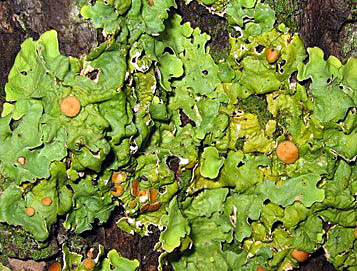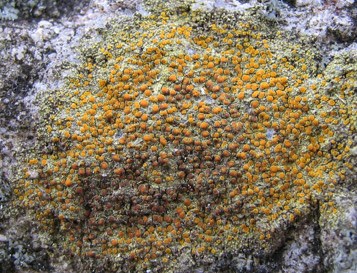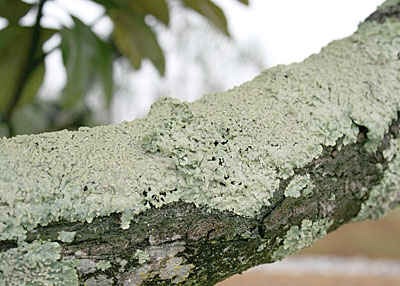Who’s Liking Lichens?
Friend or Foe
By Pat Dickey, Fairfax Master Gardener
While walking in wooded areas in the winter, with no foliage on most of the trees, you may see mysterious growths and shapes that you have never seen before. Some appear crusty and grow on the top of rocks and on stone artifacts. Others seem to be growing beards and hanging on the sides of trees. There are also those that form leafy grayish-green shapes and appear on trees and on the ground. What are they? Will they harm the trees?

Lichens together on trunk
You are seeing a unique relationship between a fungus and an alga that allows them to mutually benefit from each other. The fungus provides a place for the alga to live, with moisture retention and a surface on which to grow. The alga provides nutrients for the fungus through photosynthesis. The two have formed a symbiotic relationship, and together are known as a lichen.

Smooth lungwort (Lobaria quercizans), a foliose lichen
A lichen (pronounced liken) does not have a stem or leaf or a vascular system and therefore is defined as a thallus structure. In this relationship, the lichen does not resemble either the fungus or the alga. The dominant part of the lichen is the fungus. Everything needed from the lichen’s environment, from the air and rain, is absorbed into its structure. Lichens often are found near moss on trees and on soil, because they absorb water from moss as well. A lichen does not have a waxy, protective layer like a plant leaf and grows very slowly, up to 3/4 inch a year. It begins to grow when sunlight is able to reach it, when surrounding trees are without their leaves.
There are four types of lichens:
- Crustose lichens form a crusty appearance over a surface and have many bright and vibrant colors, such as yellow, orange and red, as well as gray and green. Water enhances the colors after a rain. They occur on rocks, wood, glass, roof tiles, pavement and on the bark of trees. They are so closely attached that they appear to be painted on.
- Fruticose lichens stand upright and are shrubby with round branches that have a central core or are hollow in the middle. There are some with flat branches that seem tangled up with each other. Many are found a long distance above the ground on the branches of a tree.
- Foliose lichens are very flat and leafy in appearance, like lettuce, with a distinguishable top and bottom surface. They can also be full of ridges and bumps. They are attached to a surface by means of rootlike structures called rhizines.
- Squamulose lichens are an intermediate form between the foliose and crustose types. It is a scalelike form and consists of numerous small scales (squamules). They can occur in dense patches that are quite large, even though each scale is no more than 3/8 inch. They are commonly found on the upper surfaces of dead logs and stumps.

Sulphur-firedot lichen (Caloplaca flavovirescens), a crustose lichen
The beneficial relationship of lichens provides a mode of survival for algae in harsh environments where they would not normally survive. This enables algae to live all over the world as long as there are occasional rain showers to allow the lichens to recharge and store food for the next dry period. Lichens have little control over the water that is gained or lost. They can fortunately tolerate periods of severe desiccation, entering into a metabolic suspension in which biochemical activity stops.
Lichens are sensitive to poor air quality. They absorb pollutants from heavy metals, carbon or sulfur dioxide, allowing scientists to extract these toxins and study their levels. Lichens also contribute nitrogen and minerals to their ecosystems, and scientists can detect serious changes in ecosystem health from them.

Spreading Squamulose lichen
Lichens are a food source for caribou in the colder climates of North America. They make up 90 percent of the caribou’s diet in the winter and 50 percent in the summer. Hummingbirds use lichens for their nests, camouflaging their nests from predators. Caterpillars of a particular species of nocturnal moth, Noctuidae (owlet moths), feed on lichens.
A way to remember the symbiotic relationship of a fungus and an alga is this riddle: “Did you hear the story of a fungus meeting an alga and they took a lichen to each other?” There is no need to remove lichens from your trees, since they will not cause any harm. Even though they look like something from another world, lichens are our friends for sure.
…updated 2025
- References
- Do Lichens Cause Harm to Trees?, Scott Weikert, Penn State Extension
- Lichens, US Forest Service
- Lichen, Algae, and Moss on Trees, University of Maryland Extension
- Lichens, Shenandoah National Park (Virginia), National Park Service
- The Kingdom Fungi: The Biology of Mushrooms, Molds and Lichens, by Steven L Stephenson